G8 Speakers' Meeting
Delivered: prayers from the heart
On September 2, the lower-house speakers of eight countries, plus the president of the European Parliament, held discussions in Hiroshima at the site of the nuclear attack. This was the Group of Eight (G8) Speakers' Meeting.
The Speakers' Meeting was closed, and the participants' remarks were not revealed. However, at the post-meeting press conference we were delighted when Yohei Kono, the speaker of Japan's House of Representatives, announced that all participants intended to cooperate in the realization of the "youth summit" in Hiroshima proposed by the Peace Seeds junior writers.
On the other hand, we were disappointed that we were unable to ask the speakers in person about their impressions of the A-bomb survivors' talk and the Peace Memorial Museum. As an alternative, we sent them e-mail messages and have received replies from six countries, including Russia and the United States.
Just before the meeting, we delivered messages of peace to the speakers from students of elementary and junior high schools in Hiroshima City. In this issue we will display their replies and summarize our impressions of the Speakers' Meeting.
messages from each speaker  Messages from Hiroshima children
Messages from Hiroshima children  The Speakers' Meeting as we saw it
The Speakers' Meeting as we saw it
|
U.S.A. The visit to Hiroshima is a powerful reminder of the destructiveness of war, underscoring the urgency for all nations to promote peace and to build a better world. |
|
Russia My visit on this occasion to Hiroshima's Peace Memorial Museum raised my awareness of the tragic results of a war in which weapons of mass destruction are used. The international community needs to cooperate in efforts at nonproliferation of such weapons, including nuclear weapons, and to work consistently towards their reduction. Russia has been making every effort towards that, and we will continue to do so. |
|
The United Kingdom Visiting the peace memorial at Hiroshima is a sobering and vivid reminder of the horror of the effects on human beings of the use of nuclear weapons. Whatever the causes of the Second World War a visit to Hiroshima and our discussions here must strengthen our collective will to avoid nuclear engagement at all costs. Parliaments have a significant role to play in such a process since they are the focal point for scrutiny and control of armaments and the checking of executives in their war-making powers. |
|
France Here, in Hiroshima, a city more ravaged than any other after so many appalling conflicts that have occurred throughout the history of the world, it is our absolute duty to remember in order to inform the current and the future generations so that such tragedies can never happen again. It is in peace only that humanity can grow in stature. |
|
Canada There is a saying about history: "Those who cannot remember the past are condemned to repeat it." In creating this place of tribute and remembrance, the people of Hiroshima, indeed, of all Japan, have reminded the world that while it is in our power to destroy ourselves, it is also possible for us to overcome sorrow and anger and, like the phoenix, to be reborn from the ashes of destruction. I humbly thank the people of this city for their gift of knowledge and memory, and I pray that all those who come here learn its message of peace and hope. |
|
Italy I am very pleased to convey my warmest greetings to the editors and to the young readers of Peace Seeds. The visit to the Hiroshima Peace Memorial Museum on 2 September last was for me an especially moving occasion with a profound ethical and cultural meaning. As I have pointed out, the tragedy that occurred on 6 August 1945 affected the entire world, not only the Japanese people. The memory of the nuclear holocaust brings again the complex issues of disarmament and the non-proliferation of weapons of mass destruction to the attention of peoples and their elected representatives. We need to identify the appropriate procedures in order to launch a fruitful debate on these issues within the international community. This is a major challenge which Western diplomacies must be equal to and to this end those who, like you, endeavour day by day to create a better world can make a fundamental contribution: a world where peace can be the core value of individual and collective action. |
|
Germany "Visiting Hiroshima was a deeply moving experience for me, particularly the ceremony of remembrance in the Peace Memorial Park. The victims of Hiroshima represent a warning to us to do everything in our power to make our world more peaceful and human. The G8 Speakers' Meeting has shown that the parliaments of the G8 states are very conscious of their own responsibility in this context. The idea of a children's summit is one I can only welcome. The future belongs to children and young people. They should therefore have opportunities to develop their own ideas and conceptions of a peaceful and fair world, their own visions of a future which is worth living. A children's summit would be a wonderful forum for this." |
Messages to the speakers from Hiroshima children
 Children presenting the messages and thousand cranes to the speakers |
Messages of peace were presented to the speakers by 18 children from 16 elementary, junior high and special education schools in Hiroshima. Each message was written on a sheet of A4-sized paper and accompanied by 1000 folded paper cranes. These 18 children represented all the children of 178 municipal schools in Hiroshima City, who made the cranes.
After the speakers laid flowers on the Cenotaph, the messages were presented to each speaker by two students. The speakers greeted the students cheerfully, and commemorative photos were taken.
Chiharu Ehira, 9, a fourth-grade student at Mukainada Shinmachi Elementary School, made the presentation to Mr. Martin of the U.K. "I was nervous, but he said 'thank you' to me, and I think he understood our wish for peace. He talked to me a lot."
Yoko Kasama, 14, who is in ninth grade at Ujina Junior High School, was assigned to Mr. Lammert of Germany and was very happy with the experience. "He seemed kind and friendly. I hope he takes our messages back to his country and Hiroshima's hope for peace will spread from there to the world." (Seira Furukawa, 15)
|
Honkawa Elementary School |
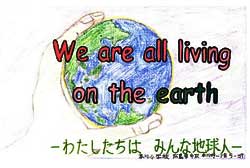
|
Ideas from 53 sixth-grade students at Honkawa Elementary School were brought together to produce this message. A hand holding a globe is shown, and on top of that, "We are all living on the earth" is written in pink and green, in English and Japanese respectively. Three ideas were selected by the students and combined into one. Considering that some nuclear powers were participating in the meeting, they wanted to express the idea that nuclear weapons deprive people of their happiness. Three students were in charge of the drawing and coloring. Fumiya Hori, 12, who drew the hand, says, "I hope people think of the importance of peace." Nao Yokota, 12, in charge of the globe, hopes for a peaceful world without nuclear weapons. |
|
Kogo Elementary School |
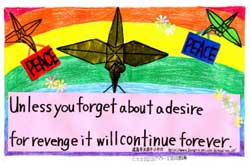
|
Students at Kogo Elementary School created a design in which three paper cranes, holding messages in their beaks, appear in front of a seven-colored rainbow. The crane in the middle of the picture holds a message saying, "Unless you forget about a desire for revenge it will continue forever." The other two cranes display the one-word message "Peace." The design is by a sixth-grade student, Minami Ishikawa, 12. The message was inspired by the words of her grandfather, an A-bomb survivor. The English translation was completed with the help of a friend of her mother, a junior high school teacher. She used English in order to convey this thought to the people of the world. She says her hopes for peace were strengthened after listening to a survivor's testimony in her peace education class. |
|
Yoshijima Junior High School |
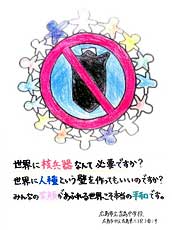
|
The eight members of Yoshijima Junior High School's student council created the school's message, which uses words and an illustration to appeal for an end to both nuclear weapons and racial discrimination. A black nuclear bomb is shown inside a red circle with a slash, representing its abolition, and around that is a circle of people standing hand in hand. Below this picture is the message, "Are nuclear weapons really necessary in the world? Is it good to build walls out of racial differences? A world full of smiles means genuine peace." The student council chair, Azusa Masaoka, 15, told us that the Speaker's Meeting renewed the students' awareness that Peace Memorial Park is within their district, and that "we who are so close to it should study it thoroughly and be able to transfer this knowledge to others." |
|
Itsukaichi Minami Junior High School |
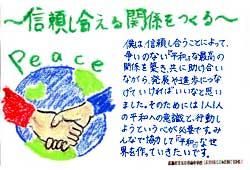
|
The message of Itsukaichi Minami Junior High School features two hands shaking, with a blue and green globe in the background. The title is "Build trusting relationships." The message says, "I hope we can build good relationships through mutual trust, so that we can help one another to progress and develop. This requires everyone's commitment to peace and willingness to act on it. I want to build a peaceful world through cooperation." The message was written by Hideki Wakasa, 15, a third-year student. The shaking hands symbolize his hope that weapons and nuclear materials can be abolished through the leadership of people who respect and trust one another, overcoming their national and ethnic differences. |
|
Inokuchidai Junior High School |
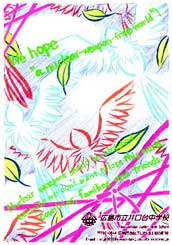
|
The message of Inokuchidai Junior High School shows a scene of white and orange doves and fluttering leaves against a blue sky. The message says, "Nuclear weapons should be abolished because our world, our country, our families and our friends are precious to us." Two third-year students, Miwako Kawasaki and Tomomi Shiozaki, both 15, created the picture using watercolors and colored pencils. Tomomi explained that she felt painting enabled her to express her thoughts better than using words alone. Miwako said that she had a difficult time drawing the doves taking flight. "Those doves taking off into a perfect sky represent people who are devoting their best efforts to bring about peace."
|
|
Rikako Okada,18, Risa Kushioka,17, Moeko Takaki,13, and Rika Shirakawa,12, |
 A bomb survivor's story
A bomb survivor's story
At the Peace Memorial Museum, atomic bomb survivor and former museum curator Akihiro Takahashi, 77, described his experiences with the bomb to the visiting participants of the Speakers' Meeting. In front of a museum exhibit displaying his deformed fingernail (resulting from an injury inflicted by the bomb), he told his story in a traditional "kamishibai" format, using picture cards to illustrate his story.
The participants listened quietly to his vivid descriptions, such as that of a woman whose eye had popped out. One participant, arms crossed, looked at the pictures deep in thought. Another frowned and nodded. From the serious expressions they wore as they listened, it appeared that the speakers were deeply moved by Mr. Takahashi's words.
We interviewed Mr. Takahashi after his talk. "I hope all the visiting speakers will retell what they saw and heard at the museum directly to the children who will carry on their work in the future," he said. I think these words express his strong hope for a peaceful world free of nuclear weapons. (Nao Tatsugawa, 16)
 Handmade flags welcome the Speakers
Handmade flags welcome the Speakers
 Children from Hiroshima City welcoming the Speakers with handmade flags |
About 550 students from seven elementary schools in Hiroshima City welcomed the lower-house speakers with flags of the European Union and the G8 countries. The flags had been made by students.
The students enthusiastically waved the flags on both sides of the walkway leading to the Cenotaph, and some of the speakers waved back and smiled at them. I joined those students, and we waved the flags together.
Shota Ueno, 12, a sixth-grader at Senda Elementary School, said, "I was careful to keep smiling as I waved the flag." Yuko Yokochi, 12, from the same school, told me that her gaze met that of one of the speakers, and she was happy that he waved back at her. (Aoi Otomo, 13)
 The significance of holding the Speakers' Meeting in Hiroshima
The significance of holding the Speakers' Meeting in Hiroshima
After the Meeting, a press conference was held at International Conference Center Hiroshima. Six speakers were able to attend, while those from Russia, Italy and the European Union could not be present because of their tight schedules. At the press conference, Japanese Speaker Yohei Kono, host of the meeting, spoke while the other participants stood behind him.
Speaker Kono announced that during the lunch period he had proposed holding a youth summit in Hiroshima, and all the other participants had agreed to it.
The idea for a youth summit came from a proposal that we made during our interview with Mr. Kono in March at his official residence in Tokyo. We are very pleased that a big step has been taken toward the realization of that idea.
Although the contents of the closed meeting were not revealed in detail, Speaker Kono announced that the participants had affirmed their commitment to work toward abolishing nuclear weapons and building a peaceful world. They discussed enhancements to the Nuclear Non-Proliferation Treaty, and I got the impression that they had managed to reach the core of the issue.
Among the Speakers' Meeting participants, only the Japanese and American speakers were born before the bombing of Hiroshima, so the bomb survivor's story and the visit to Peace Memorial Museum must have made a big impression on the speakers. According to Mr. Kono, the abolition of nuclear weapons will be difficult to achieve, but they intend to work towards that goal step by step, and he added, "For discussions of peace and disarmament, there is no location more suitable than Hiroshima." Judging from these words, I felt that the meeting must have been successful. (Risa Kushioka, 17)
 Paying respects at the Cenotaph
Paying respects at the Cenotaph
 Lower House Speakers joining hands in front of the Cenotaph |
Guided by Hiroshima Mayor Tadatoshi Akiba, the speakers presented flowers at the Cenotaph for A-Bomb Victims in Peace Memorial Park. They walked to the Cenotaph side by side, then individually laid flowers on the Cenotaph, bowing and closing their eyes in prayer for the bomb victims.
Mayor Akiba talked about the history of Peace Memorial Park, mentioning the story of Sadako Sasaki (the model for the Children's Peace Monument), noting that the area of the park was a busy commercial district before the war, and explaining that in the inscription on the Cenotaph ("Let all the souls here rest in peace, for we shall not repeat the evil"), it is understood that "we" means "all of humanity."
Finally, all nine participants joined hands and bowed in front of the Cenotaph. It seemed to be an indication that the world's major nations would join hands to make an effort at peace. At that point it seemed to me that the meeting to come would make some progress. (Nao Tatsugawa, 16)
|
Click to watch the speakers' visit to Peace Memorial Park and the students' welcome |
 Students entertain accompanying staff with Japanese music
and dance
Students entertain accompanying staff with Japanese music
and dance
On the night of September 2, after the Speakers' Meeting, students of elementary schools and junior high schools in Hiroshima welcomed the embassy and lower-house staff who accompanied the speakers. A welcoming party was held in an elegant Japanese-style restaurant, where the students performed Japanese dance and music.
Forty students from the Motomachi area of Hiroshima City gave a performance of "Soran Bushi," a famous Japanese traditional dance, in the restaurant parking lot where the staff bus arrived. This is a lively dance, performed while singing to up-tempo music. Elke Tiedt, the German vice consul general, was impressed with the performance and commented, "That's great. I think everyone enjoyed it very much."

|
Junior high student Benika Yukimura, 13, one of the dancers, said that she was happy to express a bit of Japanese tradition to the visitors, even if only a small part of it.
While the staff enjoyed walking in the Japanese garden, five student members and one adult member of the Hiroshima Hougaku (Japanese music) Federation played koto (photo). They performed some famous Japanese children's songs.
The staff took pictures of the performers as they played wearing their kimono. Soeren Roos, a staff member of Germany's lower house, was pleased with the beautiful, exotic tone of the koto, and commented that the children's kimono were charming.
One of the performers, sixth-grade student Namiko Iwai, 12, said, "I think they were able to appreciate our traditional Japanese music." (Nao Tatsugawa, 16, Seira Furukawa, 15, and Aoi Otomo, 13)
 Souvenir 1 ---- Tourist map of Hiroshima
Souvenir 1 ---- Tourist map of Hiroshima
|
Click to watch the interview at Hiroshima Convention & Visitors Bureau |

|
Hiroshima Convention & Visitors Bureau made tourist maps in various languages and sent them to each embassy in advance of the Speakers' Meeting.
Each map is 36 cm high and 51 cm wide and is printed in color. There is a map of the city center, accompanied by photos of Hiroshima Castle and Shukkeien Garden, plus a hotel list. It can be folded and carried conveniently in one's pocket.
The map has been produced in six editions -- Japanese, English, Italian, German, French and Russian. The bureau has printed 200,000 copies in Japanese, 70,000 in English and 5,000 in each other language. They also plan to publish Chinese and Korean versions for the many tourists who come here from China, Taiwan and Korea.
Manager Seishi Kamaike, 39, said that they had already published maps in these languages, but they have now improved the contents. (Yuka Iguchi, 13)
 Souvenir 2 ---- Booklet of atomic bomb experiences
Souvenir 2 ---- Booklet of atomic bomb experiences

|
Hiroshima City produced a booklet written by Hiroshima Peace Memorial Museum's former curator, Akihiro Takahashi, 77, who told the speakers about his experiences with the bomb during their visit to the museum. The booklet, titled "Toward a nuclear-weapon-free world --An appeal from Hiroshima was presented to all the speakers. The 61-page booklet, composed of words and pictures, is 10 cm tall and 12 cm wide.
A Hiroshima artist, Goro Shikoku, 84, created the paintings and drawings, which are the same pieces used in Mr. Takahashi's illustrated talk at the museum on the day of the Speaker's Meeting. In the color pictures, showing people with bodies burned and riddled with glass shards, the horror of the atomic bombing is well expressed.
Nobuyuki Teshima, Hiroshima City's Chief of International Peace Promotion explained that there was not enough time in the speakers' schedule for Mr. Takahashi to give a detailed talk, so the booklet was produced to help the speakers achieve a better understanding of the events. Japanese and English editions were printed, each consisting of 100 copies. (Minako Iwata, 15)